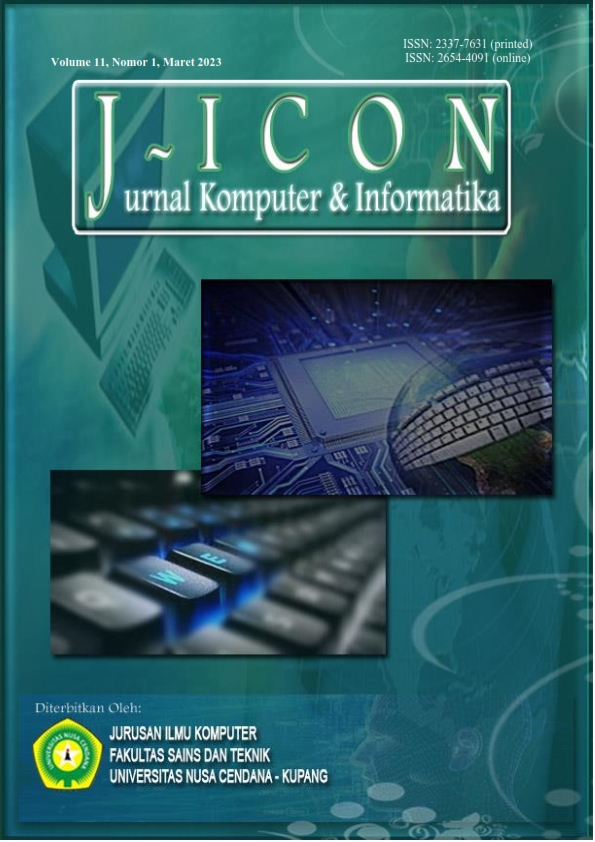INFORMATION SECURITY IN PERSONNEL MANAGEMENT INFORMATION SYSTEM APPLICATIONS WITH DEFENSE IN DEPTH
Abstract
The rapid development of Information Technology (IT) has made IT the most important aspect to meet organizational needs. The existence of IT is believed to be able to provide solutions related to the organization's business processes, so that many organizations offer their resources to increase efficiency by relying on information technology support. Information system security is an internal organizational subsystem tasked with managing the risks associated with computerized information systems. Information system security is the application of international control principles, which are specifically used to trigger problems in information systems. Important information leads to protected information structures, more information is now available from the internet, so information management now includes computer and network technology. The goal of information security is to strengthen business operations and protect against falling business prices by minimizing the risks associated with internal security. The purpose of this study is to understand information security in the implementation of the Personnel Management Information System (SIMPEG) at Sebelas Maret University. The research method used is the application of Defense In Depth to analyze information security, including many layers of security to ensure information security. The results of the descriptive analysis explain that the design and development of SIMPEG pays attention to the principles and aspects of data and information security. However, information security vulnerabilities can occur at the server protection layer, network protection layer, and physical protection layer.
Downloads
References
L. M. M. Matin, A. Arini, and L. K. Wardhani, “Analisis Keamanan Informasi Data Center Menggunakan COBIT 5,” Jurnal Teknik Informatika, vol. 10, no. 2, pp. 119-128, 2017, doi : https://doi.org/10.15408/jti.v10i2.7026.
M. Hayati, and D. Fata, “Analisis Keamanan Informasi Pengguna Media Sosial Menggunakan Setoolkit Melalui Teknik Phising,” Djtechno : Journal of Information Technology Research, vol. 2, no. 1, pp. 21-28, 2021, doi : https://doi.org/10.46576/djtechno.v2i1.1252.
I. A. Dianta, and E. Zusrony, “Analisis Pengaruh Sistem Keamanan Informasi Perbankan pada Nasabah Pengguna Internet Banking,” INTENSIF : Jurnal Ilmiah Penelitian dan Penerapan Teknologi Sistem Informasi, vol. 3, no. 1, pp. 1-9, 2019, doi : https://doi.org/10.29407/intensif.v3i1.12125.
E. M. Safitri, A. S. Larasati, and S. R. Hari, “Analisis Keamanan Sistem Informasi E-Banking Di Era Industri 4.0 : Studi Literatur,” JIFTI - Jurnal Ilmiah Teknologi Informasi dan Robotika, vol. 2, no. 1, pp. 12-16, 2020, doi : https://doi.org/10.33005/jifti.v2i1.25.
A. Elanda, and R. L. Buana, “Analisis Keamanan Sistem Informasi Berbasis Website Dengan Metode Open Web Application Security Project (OWASP) Versi 4 : Systematic Review,” CSS (Journal of Computer Engineering System and Science), vol. 5, no. 2, pp. 185-191, 2020, doi : https://doi.org/10.24114/cess.v5i2.17149.
Zulkarnain, “Analisis Implementasi Keamanan Sistem Informasi Pada Perusahaan Perakitan Elektronik,” Journal of Information System and Technology, vol. 1, no. 1, pp. 1-4, 2020 .
A. P. Galih, “Keamanan Informasi (Information Security) Pada Aplikasi Perpustaakn iPUSNAS,” Al Maktabah Jurnal Kajian Ilmu dan Perpustakaan, vol. 5, no. 1, pp. 9-17, 2020, doi : http://dx.doi.org/10.29300/mkt.v5i1.3086.
T. E. Wijatmoko, “Evaluasi Keamanan Informasi Menggunakan Indeks Keamanan Informasi (KAMI) Pada Kantor Wilayah Kementerian Hukum Dan HAM DIY,” CyberSecurity dan Forensik Digital, vol. 3, no. 1, pp. 1-6, 2020, doi : https://doi.org/10.14421/csecurity.2020.3.1.1951.
M. B. Yel, and M. K. Nasution, “Keamanan Informasi Data Pribadi Pada Media Sosial,” Jurnal Informatika Kaputama (JIK), vol. 6, no. 1, pp. 92-101, 2022, doi : https://doi.org/10.1234/jik.v6i1.768.
F. Novianto, “Evaluasi Keamanan Informasi E-Government Menggunakan Model Defense In Depth,” CyberSecurity dan Forensik Digital, vol. 3, no. 1, pp. 14-19, 2020, doi : https://doi.org/10.14421/csecurity.2020.3.1.1962.
Copyright (c) 2023 Enggar Novianto, Erik Iman Heri Ujianto, Rianto Rianto

This work is licensed under a Creative Commons Attribution 4.0 International License.
The author submitting the manuscript must understand and agree that if accepted for publication, authors retain copyright and grant the journal right of first publication with the work simultaneously licensed under a Creative Commons Attribution (CC-BY) 4.0 License that allows others to share the work with an acknowledgment of the work’s authorship and initial publication in this journal.
 Enggar Novianto(1*)
Enggar Novianto(1*)




